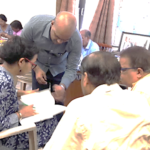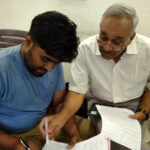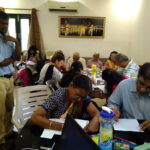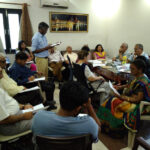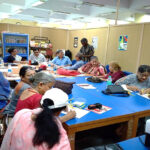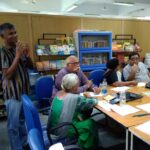A few words on the
Training of the Elderly Educators
2018 - Capacity building Sessions
Education is a noble mission to train the young budding minds to think and understand the integrated outlook of life as a human being. Capacity building of Elderly as an Educator is prerequisite beforehand introducing them to school system and furnish flow of knowledge in cooperative classroom culture, where learner/children acquire knowledge, skills, positive attitude and value for life.All ‘well educated’- Graduates/ postgraduates retired senior citizens from any Government/Non-government organisations or sectors with sound physical and mental health are chosen to undergo training sessions from Delhi and NCR.
Different subject wise training session were conducted in an attempt to build capacity and orient Elderly Educator on Children’s Learning strategies & teaching methodologies in the teaching- learning process. The major focus of session was on to understand- what and how children learn and what is the role of Educator, how they can facilitate and make the process of learning better, smooth and enjoyable for students, etc to increase retention rate in schools and learning outcomes.
1. First training session was led by Dr. M. V. Srinivasan, Associate Professor from Department of Education in Social Sciences, NCERT on ‘Briefing on National Curriculum Frameworks-NCF 2005’ and looking at the other National Curriculum designed till now.The National Curriculum framework work as guidelines and are subjected to changes. According to the NCF 2005, the expectations of framework are instilled in our curricular. With NCF 2005 there have been 21 focus group papers written and published in different subjects and focusing from class 1 till 12th grade.
In a participatory activity Dr. Srinivasan distributed 4 different National Curriculum frameworks around the room and asked elderly educator to mark the changes in NCF with time or change in governments, what could be the objectives behind making changes or reasons of evolution of NCF, how government policies determine the strategies of education system, etc. He highlighted on the inclusive methodologies of teaching, giving due importance and acknowledgement to the local surroundings of child and emphasized on the need of Hands on activity to gain experiences.
2. Second training session was facilitated by Dr. R Meghanathan, Associate Professor from the Department of Education in Languages, NCERT on “How Children Learn” He emphasised on the practical base behind learning outcomes and how most of the learning focus on language learning. He reiterated on the potential of a child to learn its mother tongue at the age of 3 without being taught by anyone, therefore highlighting language being a social concept.
In the process of training, number of activities related to Listening, writing & Comprehension were given to Educators. In the first one the class was divided into pairs and the partners had to finish the story written in two sheets of paper. This helped the class comprehend the story, and then he told everyone to shut their eyes and simply hear. Through various examples he showed how one can work towards comprehending English as a language.
At the end of the class he made 6 points on the board :
- Children work with languages.
- Reading, re-reading help to promote reading.
- Stories are sources for language learning.
- Integrate skills.
- Teach vocabulary in chunks.
- Use English language for pragmatic purpose.
3. Third Training session was facilitated by Ms. Neena Maini, Head Mistress from Indian School, Delhi on “Modes of Differential learning”. In a class, each child’s requirement should be taken into consideration and a very significant point highlighted by Neena ji was that the educators must know the name of each child as the class progresses.
Each child must be made to feel special. She gave suggestions and solutions on how to break the monotony of class and keep attention of students in class without being diverted. Games like “Simon Says” also helps to keep the students engaged and excited in class. She also spoke about the ‘password’ game she played with her students where everyday a new word was the password which the students had to use when they spoke to the teacher.
In recent times with the emergence of YouTube and Google we all have much more access to interesting educational activities, rhymes, stories, etc. Ma’am encouraged the educators to use the resources to make each class thought-provoking and enriching. Among various method’s, Peer to Peer conversation on teaching imparts is very touching.
Highlighted on different types of learning-
- Visual
- Aural
- Reading
- Kinesthetic, etc
4. Fourth Training session was facilitated by Dr. Pushpendra Singh from District Institute of Education and Training, (DIET) Government of Delhi on “Constructivist approach of Mathematization”. The concept of Mathematization means that students should not just be taught math but think in terms of math as well and students should be encouraged to learn maths rather than memorizing formulas.
He explained this beautifully with a “Answer to Question” activity. Dr.Singh says that the NCF 2005 enshrined the following principles:
- F meaning flexibility
- E meaning external world
- A meaning all around development
- R meaning rote learning
- D meaning democratic values
He also stated the example of tables and sticks activity where students in elementary classes can be taught addition, subtraction, multiplication as well as division. They simultaneously learn counting and numbers. It was very interestingly highlighted by Dr.Singh how the calendars have a pattern which repeats itself after few years. He told the educators to encourage the students in activities like writing a calendar where they find out such similarities and differences. He stated that from calendar mean and average can be taught by blocking out few dates and weeks.
5. Fifth training session on “Developing scientific temper in Children” was facilitated by Dr. Gagan Gupta, Associate Professor from Department of Science and Mathematics, NCERT. Dr. Gagan session was very interactive and full of scientific mysteries. A session driven by Questions and curiosity. Dr. Gagan stated that when there is interaction in between class to break the monotony, the beautiful individuals come to life. Dr. Gupta specified that the questions children ask should be taken with due consideration. Students have asked him “Will robots over power humans?” and “Does life exist beyond planet earth?”
Dr. Gagan showed the educators a picture of moon close to a water body which was supposedly shot in Norway. He asked the educators why does the moon look smaller to us, why it is so large in Norway? This is the same question in the minds of children when they cannot understand the reason. His first activity stated the distance of a man from three buildings, the first one smaller than the other two but nevertheless the man will feel the closest building is biggest due to his proximity with the building.
Dr. Gagan’s second activity was more like a magical mystery and it made everyone sitting in the room enthusiastic with energy. He shared with each individual picture of an elephant. At first the elephant did not seem mischievous but when Dr. Gupta asked the elderly to sketch the elephant they all realized the sudden fifth leg cropping out. To the amusement of the educators when the picture is folded from bottom the fifth leg seems to vanish. This experiment goes to show how we usually tend to jump to a conclusion. It is important to look at the limb of the elephant from where the leg will be joined. Students similarly tend to simply use a formula without knowing its use.
For his next activity he showed the educators a bunch of words like “Yellow, Blue, Green, Red, etc.” but the words did not denote the colour it usually does. To be more precise yellow may have been coloured in green, green may be coloured in red, so on and so forth. He tried to show how reading a word is much easier when the colour and the word maybe same but difficult when the eyes don’t know which to trust. He similarly created a stream of the words:
To keep saying the word stream becomes a task for the brain to detect what one wishes to say. So words must be separated in a way that it all makes sense to the students, for the brain to be receptive of the learning.
Dr.Gagan’s explained through another activity what the eye receives and what it sees. A picture seen from one eye will be different from the eye, primarily its positioning changes. It is the function of the retina and the optical nerve which demarcates the two vision. When both the eyes see, the vision is best. Now to add another level to the activity he told all the educators and members present to roll up a paper and hold it next to the eye such that the eye is completely covered. Through the eye one can have a clear vision. With the other hand he told to put it beside the rolled up paper and the palm must be open facing the individual. To the excitement of everyone in the room the other hand seems to have a hole in the hand.
Dr. Gagan explained that it is the default vision due to the wrong information sent to the brain by the optical nerve and this creates the illusion of hole in the hand. The next activity was on understanding the human body without the help of any book. Dr. Gagan asked Archana Ma’am, our educator for the Noida Purva Madhyamik Vidyalaya, Sector 12, to come forward and help him with the experiment. He told Ma’am to stretch her right hand and he stretched left hand such that both their fingers meet when they are standing side by side. After a point of stretching a shoulder exercise of the stretched hand is carried out for 30 seconds and then the hands are stretched again and this time the hands stands to pain. This explains the contraction and expansion of the muscles.
In another experiment he put a phone inside an empty glass. When the phone rings the sound is much more than usual but when he held it close to his mouth, the sound was not audible. The air was inhaled and a partial vacuum was formed. But the light of the phone was visible. This experiment shows that light does not require a medium to travel but sound does.
In his following experiment he used a paper box with one side of the box having a plastic transparent sheet. He lit up few incense sticks and place it inside the box, there were pieces of glass inserted in the box too. From the outer surface he placed two laser light torch of different colour. After the smoke engulfed the box the light rays passing straight from one glass to the other was clearly visible. And since the smoke was too dense the scattering of light was visible.
6. Sixth training session was facilitated by Dr. Sandhya Singh, Head of the Department of Languages, NCERT on “Methodology of Teaching and Processes of Learning Hindi Language”. She begun her session with statement that we keep thinking hindi is a ‘lingua franca’ but there are many areas of India where people do not know Hindi language. Dr. Singh spoke about the significance of Hindi Cinema which has made people learn the language even though it isn’t their mother tongue. Dr.Singh interestingly stated how each language has been developed by taking words from the other languages. English for example has been growing over the years because it has taken words from other languages.
Dr. Sandhya pointed that the most important way a child learns is by understanding the context. Children may act the action they see in the surrounding but only imbibe it when they realize the context. They even add logical validation to their thought. Dr. Sandhya stated the example of how a child says “If it rains how my father will come?” They hear and make sense of their surroundings.
She spoke about the NCF 2005 which looks at listening, reading, writing, speaking, etc. She laid importance to reasoning as well. It is a medium of expression. The thoughts or opinion we have about gender, caste or Nation comes by virtue of the language as well. It is also very important to note that there are languages in one society which may not be relevant or acceptable in another. One word used in different ways may hold different meanings and the students should be taught. Our language has an impact in our thinking and perception. For example thoughts like “Boys do not cry”, these are thoughts which are reiterated through our stereotypical mentality. It is therefore important to critique the writings, students must be allowed to question. Dr. Singh feels that our classroom education has no scope for such discussion and questioning. With the IGLC framework she feels these barriers can be broken.
Dr. Singh asked the elderly educators to write a small essay in few minutes on our environment and our day. Through the exercise Dr. Singh showed that knowledge is not already made but it is constructed by us, through our experiences. Very interestingly she pointed that India has 1652 languages and the diversity is appalling. With Hindi specifically, the mentality has been very conservative. At first language was oral and later they all were scripted. Dr. Singh spoke about two great poets, namely, Kishori Das Vajpayee and Kamta Prasad. In his book “Hindi shabdanushasan” he spoke about the progress of any language which can be changed by a reader. He interestingly says that if one walks around the country the language gradually changes. Language has its own framework, consonant-vowel. She says that a classroom syllabus should facilitate learning. Elderly educators must encourage critical thinking.
7. The training of the Trainer session spearheaded by Dr. Ashutosh Wazalwar focussed on “Activity based Strategies for Teaching and Learning Methodology in Mathematics”. Dr. Wazalwar spoke about igniting and creating thoughtfulness among students. He asked that why do few students fear mathematics as a subject and do not opt for it in future?
Dr.Wazalwar highlighted that Students have their own observation, it is the art of the teacher to harness and sharpen it further. The students come with their own knowledge. Through the term ‘Mathematization’ a student’s opinion and their daily life situation are given primary significance. The work of the syllabus must be to clear the concepts. He said that each term or concept has its importance and its unique meaning. An attempt has been made to create books that are child-friendly and motivates the students to study. A teacher’s role is class is very significant.
The Educators were told to play a quick game of adding numbers to 100 but only 1 to 9 numbers can be used while adding. The game was in pairs and whichever player reached 100 first wins. The game was very interesting the Educators enjoyed a good laugh to realize where the trick lies in the game. Games like these help in enhancing analytical understanding, counting practice as well as mental mathematics
Dr. Wazalwar is of the opinion that a teacher must act as a facilitator. To introduce a new concept in class, he encouraged the Educators that they must initiate a similar context around which the concept makes sense. For example, each child must be encouraged to understand the pattern recognition, like if numbers are 2, 4, 6 and 8 what will come next, these help them to strengthen their base. Activities can be conducted to learn a concept or create new activities as a homework. Dr. Wazalwar stressed on creating a dynamic classroom such that each child participates with complete energy and attention.
The Educators were told to play a quick game of adding numbers to 100 but only 1 to 9 numbers can be used while adding. The game was in pairs and whichever player reached 100 first wins. The game was very interesting the Educators enjoyed a good laugh to realize where the trick lies in the game. Games like these help in enhancing analytical understanding, counting practice as well as mental mathematics. Such games cheer the students and helps in breaking the monotony. Dr. Wazalwar spoke about creating a positive thought around mathematics. Even if a child is scoring below average he or she must be encouraged, poor marks must not act as an indicator of a child’s potential. Every child has a scope to improve themselves. The teacher must rectify the faults of a child. Dr. Wazalwar stated his own experience of teaching students in a school near Gurgaon. He noticed that they were first generation learner so education support back home was nil. He stated that solving poblems like ‘2x-3x’, the students did not understand. He realized that the students did not know subtraction and integers. He taught the students through games and gradually they gained their confidence back in mathematics. Therefore it is important that their problem must be addressed. If the students are not comfortable in English, their preferred language can be used pointed Dr. Wazalwar, later it can be translated to English. In this way they learn the languages as well. Each student must be taught that they should not memorize the formulas but understand the content and where to use what. If a student forgets the formula it impacts their confidence during an exam. Also, questions and examples related to their environment help them in learning the topic well.
His effort to inform the Educators how to encourage and enrich a student was very motivating. He dealt with ways to sharpen a child’s inherent skill, to use daily life situstion in education and make sense of the surrounding. The change in education system was also highlighted by Dr. Wazalwar. The session was one of a kind and there were various new opinion the Educators had when they left. Mathematics as a subject seemed more interesting than they had themselves thought.
Conclusion from the 2018 sessions
Meaningfully and productive engagement of Elderly Educators with NDMC schools in Delhi after successful completion of Training sessions and capacity building programs.

